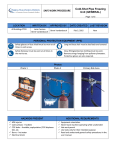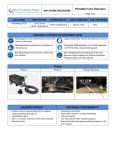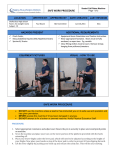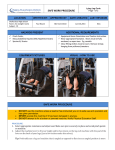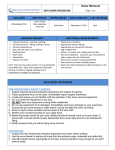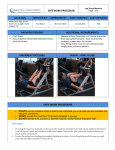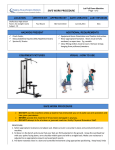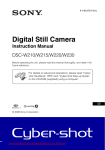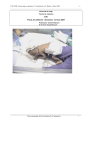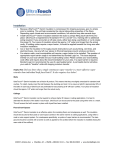Download Portable Ventilation System
Transcript
SAFE WORK PROCEDURE Portable Ventilation System (Crawlspaces) Page 1 of 4 LOCATION WRITTEN BY: APPROVED BY: DATE CREATED All Buildings PTSD Lorie Carriere Brent Vandenbosch Brent Vandenbosch April 17, 2014 LAST REVISION New PERSONAL PROTECTION EQUIPMENT (PPE) Safety glasses or face shield must be worn at all times in work areas. Long and loose hair must be tied back and covered Safety footwear must be worn at all times in the work area. Disposable P100 Respirator or a ½ mask respirator with HEPA Filters, wipes/sanitizing pads may be required. Close fitting/protective clothing must be worn. Remove strings hanging from pullovers/sweaters. Hearing protection must be worn when using this machine. Multi Gas detector (MGD) is required to be with you at all times while working in a crawl space or confined space Photos Inline blower, ducting and storage canisters for ducting HAZARDS PRESENT Electrical shock Confined space entry hazards Hazardous atmosphere Canister fan and ducting ADDITIONAL REQUIREMENTS Equipment orientation Never leave machine running unattended Use tools only for their intended purpose Read and understand general safety procedures in the user manual. SAFE WORK PROCEDURE Portable Ventilation System (Crawlspaces) Page 2 of 4 SAFE WORK PROCEDURE PRE-OPERATIONAL SAFETY CHECKS: 1. Inspect required personal protective equipment and replace if required. 2. Ensure no slip/trip hazards are present in workspaces and walkways. 3. Faulty equipment must not be used. Immediately report suspect machinery. 4. Locate and ensure you are familiar with the operation of the ON/OFF starter. 5. Do not leave this equipment running while unattended. 6. Do not use equipment if it is damaged. Immediately report any damages to your supervisor. ASSEMBLY & OPERATION: 1. Inspect and don all personal protective equipment: safety glasses / face shield, hearing protection, safety footwear, if entering a crawl space or confined space a multi gas detector (MGD) is required. Remove all jewelry; loose clothing and tie back hair. 2. If you know the approximate size of the space to be ventilated, calculate the ventilation time required to purge the space you will be working in. See the estimator guide at the back of this document. 3. Open the area to the space you will be setting up the equipment and check the atmosphere at the entrance to the space with the multi gas detector (MGD). 4. Set up the canister fan in an area where there is fresh, uncontaminated air, a minimum of 5 ft. from the opening to the space. SAFE WORK PROCEDURE Portable Ventilation System (Crawlspaces) Page 3 of 4 5. Pull the ducting from the end of the canister fan and attach it to the 90° elbow. 6. Attach the elbow to the saddle vent and place the saddle vent into the opening of the space. 7. Attach a 25’ section of duct to the other end of the saddle vent. Place the duct as far as possible into the space. 8. If more ducting is required, attach the inline fan to the far end of the 25’ duct section. Attach a second 25’ duct section to the other end of the inline fan. Stretch the ducting out as far as it can reach. 9. Turn the power to both fans ON and allow the fans to ventilate the space. Ventilate according to the calculation in step 2 prior to starting work. Continue to ventilate the space while work is ongoing. 10. Once the work has been completed, turn off the fans, remove the ducting and clean the equipment. Coil the ducting back into their storage canisters and return all equipment to storage. If an emergency situation occurs while conducting this task or there is an equipment malfunction, evacuate the area and notify your supervisor. REPORT ANY HAZARDOUS SITUATION TO YOUR SUPERVISOR IMMEDIATELY. REGULATORY REQUIREMENTS WS&H Act W210, Section 4, 5, 7, 7.1 Mb. Regulations 217/2006, - Part 15, Confined Spaces, Sections: 15.1 – 15.14 - Part 16, Machines, Tools & Robots, Sections: 16.1 – 16.13 Guideline for Confined Space Entry Operators Manual for the Saddle Vent Ventilation System and Canister Fan SAFE WORK PROCEDURE Portable Ventilation System (Crawlspaces) Page 4 of 4 VENTILATION CALCULATIONS HOW TO USE CHART 1) CONFINED SPACE SIZE CUBIC FEET 2) 3) 4) Select the proper size scale on the left. High or low, depending on the size of confined space. Place one end of a straight edge on the proper size scale at left. Place the other end of the straight edge on the blower capacity scale at right Read the required purge time from the diagonal scale that corresponds to the high or low volume scale selected. EFFECTIVE BLOWER CAPACITY CFM Purge times are calculated to achieve seven (7) air exchanges in the confined space. CONFINED SPACE SIZE CUBIC FEET 1. 2. 3. 4. 5. EFFECTIVE BLOWER CAPACITY CFM Air quality of the space should be tested prior to ventilation Ventilate the confined space for the minimum times as determine in the above chart and then retest the air. If toxic (combustible) gases or low oxygen is encountered, increase the purge times by 50% If 2 blowers are used, add the two capacities, then proceed with the how to use chart above Effective blower capacity is measured with one or two 90 degree bends in an 8” diameter, 25ft. blower hose.





